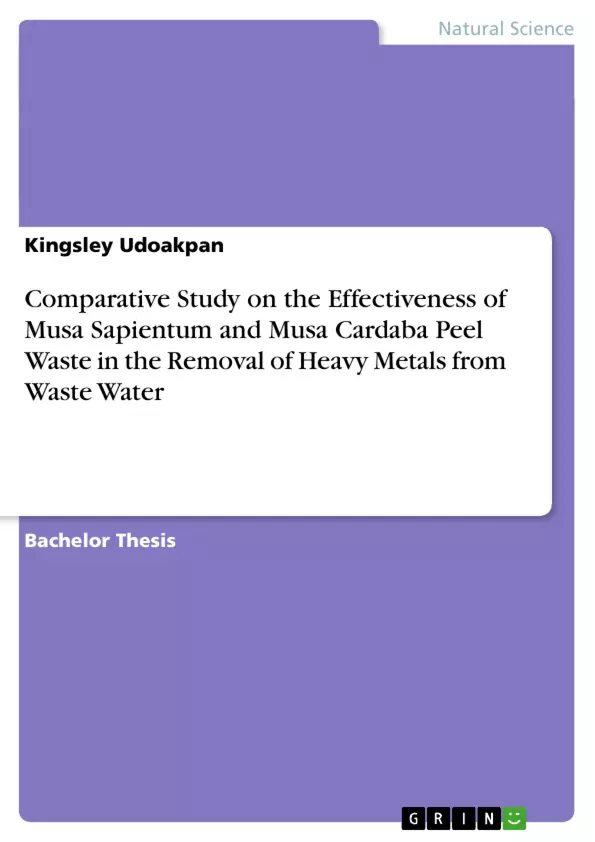Biosorption has been widely used as a more efficient alternative for the current expensive approach to heavy metal remediation from water and waste water. The effectiveness of ripe Musa sapientum (MSR) and ripe Musa cardaba (MCR) peels in the removal of Cd2+, Fe2+, Pb2+, Zn2+ ions was investigated. The amount of metal ions sorbed depended on the metal ion – adsorbent contact time, ion concentration and adsorbent weight. Weight of adsorbent was varied between 0.1 – 0.4g; contact time, 5 – 25 minutes; and ion concentration, 0.01 – 0.04M. The results indicated that Musa sapientum (Ripe) showed higher percentage sorption in removing metal ions from waste water than Musa cardaba (Ripe) peels. The peak percentage sorption of metal ions by MSR peel waste are; Cd2+ (99.95%), Fe2+ (100%), Pb2+ (100%), Zn2+ (99.92%) while metal ions by MCR peel waste was; Cd2+ (99.74%), Fe2+ (99.83%), Pb2+ (100%), Zn2+ (99.60%). The results obtained above showed that both adsorbent species are favourable for sorption and removal of the test heavy metals from their aqueous environment. Nevertheless, ripe Musa sapientum (MSR) is highly recommended for both Fe2+ and Pb2+ uptake due to its sorption capacity and efficiency.
Inhaltsverzeichnis (Table of Contents)
- CHAPTER ONE
- 1.1 INRODUCTION
- 1.2 LITERATURE REVIEW
- 1.2.1 Sources of Heavy Metals
- 1.2.2 Effects of Heavy Metals
- 1.2.3 Heavy Metals Removal Techniques
- 1.2.3.1 Chemical Precipitation
- 1.2.3.2 Ion Exchange
- 1.2.3.3 Membrane Filtration
- 1.2.3.4 Adsorption
- 1.2.4 Biosorption
- 1.2.5 Biosorption Mechanism
- 1.2.6 Advantages of Biosorption over other Methods
- 1.3 AIMS AND OBJECTIVES
- CHAPTER TWO
- 2.1 MATERIALS AND METHODS
- 2.1.1 Preparation of Adsorbent
- 2.1.1.1 Preparation of Musa Sapientum (MSR) Peel Waste
- 2.1.1.2 Preparation of Musa Cardaba (MCR) Peel Waste
- 2.1.2 Preparation of Metal Ion Solutions
- 2.1.3 Batch Sorption Studies
- 2.1.4 Determination of Percentage Sorption
- 2.2 RESULTS AND DISCUSSIONS
- CHAPTER THREE
- 3.1 CONCLUSION
- 3.2 RECOMMENDATIONS
- REFERENCES
Zielsetzung und Themenschwerpunkte (Objectives and Key Themes)
This research project investigates the effectiveness of Musa sapientum and Musa cardaba peel waste in removing heavy metals from wastewater. The study aims to determine the optimal conditions for biosorption, including the effect of contact time, ion concentration, and adsorbent weight on the removal efficiency of different heavy metals.
- Heavy metal contamination in water and waste water.
- Biosorption as an efficient and cost-effective alternative for heavy metal remediation.
- Comparison of Musa sapientum and Musa cardaba peel waste as biosorbents for heavy metal removal.
- Factors influencing biosorption efficiency, including contact time, ion concentration, and adsorbent weight.
- Evaluation of the potential of Musa sapientum and Musa cardaba peel waste as sustainable and environmentally friendly materials for heavy metal removal.
Zusammenfassung der Kapitel (Chapter Summaries)
Chapter One introduces the problem of heavy metal contamination and discusses the importance of finding efficient and sustainable methods for their removal. It provides an overview of different heavy metal removal techniques, focusing on biosorption as a promising alternative to conventional methods. The chapter concludes by outlining the research objectives and the rationale behind using Musa sapientum and Musa cardaba peel waste as biosorbents.
Chapter Two details the materials and methods used in the research. It outlines the preparation of the adsorbent materials, metal ion solutions, and the batch sorption studies conducted to evaluate the effectiveness of the biosorbents. The chapter also includes a discussion of the methods used to determine the percentage sorption of different heavy metals.
Schlüsselwörter (Keywords)
This research focuses on the removal of heavy metals from wastewater using low-cost and sustainable biosorbents. The study investigates the effectiveness of Musa sapientum and Musa cardaba peel waste in removing heavy metals such as Cd²+, Fe²+, Pb²+, and Zn²+ from aqueous solutions. Key concepts explored include biosorption, heavy metal contamination, contact time, ion concentration, adsorbent weight, and percentage sorption. The research contributes to the development of environmentally friendly and cost-effective solutions for heavy metal remediation.
- Quote paper
- Kingsley Udoakpan (Author), 2011, Comparative Study on the Effectiveness of Musa Sapientum and Musa Cardaba Peel Waste in the Removal of Heavy Metals from Waste Water, Munich, GRIN Verlag, https://www.hausarbeiten.de/document/203234


